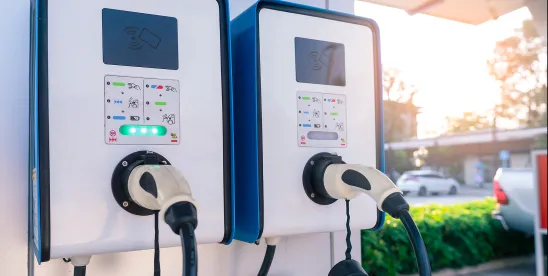The electric vehicle (EV) revolution is well underway, and with it comes a host of legal considerations, particularly around the installation and operation of EV chargers. As governments push for greener transportation options and consumers increasingly adopt EVs, understanding the legal landscape surrounding EV chargers is crucial for manufacturers, developers, and property owners alike. This article delves into a few key practical and legal considerations, as well as the regulatory frameworks shaping the deployment of EV chargers.
Regulatory Frameworks and Standards
The legal environment for EV chargers is shaped by a complex web of federal, state, and local regulations. At the federal level, agencies like the U.S. Department of Energy (DOE) and the National Highway Traffic Safety Administration (NHTSA) play pivotal roles in establishing standards for EV infrastructure. The DOE’s Alternative Fuels Data Center provides guidelines and resources for developing EV charging infrastructure, while the NHTSA sets safety standards to ensure the safe operation of EVs and their associated equipment. Further, the United States has taken significant steps to promote the development and deployment of EV charging infrastructure. For example, the Bipartisan Infrastructure Law (BIL) signed in November 2021 allocates substantial funding for EV charging stations. Under this law, the National Electric Vehicle Infrastructure (NEVI) program aims to deploy $5 billion in order to create a nationwide network of 500,000 new EV chargers by 2030, ensuring reliable access to charging infrastructure across all states.
State governments also have significant authority over EV charging infrastructure and play a critical role in shaping the legal environment for EV chargers. Many states have enacted laws to promote the installation of EV chargers, often providing incentives like tax credits and rebates. For example, California, a leader in EV adoption, has established the California Electric Vehicle Infrastructure Project (CALeVIP) to offer incentives for installing publicly accessible chargers. These state-specific regulations can vary widely, creating a patchwork of requirements that businesses and property owners must navigate.
Local governments further complicate the landscape with zoning laws and building codes that impact where and how EV chargers can be installed. Municipalities likely have specific requirements for permitting, site selection, and accessibility, which can influence the feasibility and cost of deploying EV charging stations.
Understanding this regulatory patchwork is essential for the successful development of EV charger projects.
Preliminary Considerations for EV Charger Installations
The process of installing an EV charger project typically involves a multi-step process requiring coordination between the property owner, installer, equipment manufacturer(s), local authorities and utility company. The process often involves the following steps:
- Site and Financial Assessment: Evaluating the suitability of a location for EV charger installation, considering factors like electrical capacity, accessibility, and proximity to potential users. Economic analysis is also performed by taking into consideration the availability of various tax incentives and rebates, as well as the potential user base.
- Contract Negotiation: One or more contracts between, at a minimum, the property owner and installer that dictate the legal terms of the arrangement.
- Design and Planning: Developing plans that meet local zoning laws, building codes, and ADA (Americans with Disabilities Act) requirements for accessibility.
- Permitting: Submitting applications and obtaining permits from local building departments. This can include electrical permits, zoning permits, and, in some cases, environmental impact assessments.
- Installation: Conducting the physical installation of the charging equipment, which must comply with National Electrical Code (NEC) standards and any additional local requirements.
- Inspection and Approval: Undergoing inspections by local authorities to ensure compliance with all applicable codes and regulations.
Navigating this process requires a thorough understanding of the overall project and effective coordination with the stakeholders, and while these steps can be nuanced and deserve attention in their own right, this article offers a high-level look at some contractual considerations related to the installation of EV chargers.
Contractual Considerations
As mentioned, the construction of EV chargers often involves multiple parties, including property owners, contractors, equipment suppliers, and utility companies. Clear and comprehensive contracts are essential to define the roles and responsibilities of each party and to allocate risks appropriately. A non-comprehensive list of key contractual considerations include:
- Scope of Work: The contract should clearly outline the scope of work to be performed, including specific tasks, timelines, and deliverables. Great consideration should be given to exactly what is expected of each party. For example, if the ultimate owner of the EV charger is looking for a turn-key solution, the contract should reflect that arrangement.
- Payment Terms: Payment schedules, milestones, and conditions for payment should be clearly defined to avoid disputes.
- Warranties and Guarantees: The contract should specify the warranties and guarantees provided by contractors and suppliers, including the duration and scope of these warranties. Additionally, thought should be given to how such warranties and guarantees will interact with the long-term operations and maintenance of the EV charger.
- Maintenance: Ongoing maintenance obligations, uptime guarantees, and procedures for handling ordinary wear-and-tear, as well as malfunctions, can help ensure a smoother project.
- Indemnification Clauses: Including indemnification clauses in contracts can help allocate risks among the parties from liabilities arising from the actions or negligence of other parties. As such, it is important to ensure adequate protections against such risks and these provisions are often heavily negotiated.
- Insurance: Adequate insurance coverage is essential to protect against potential liabilities, and often interplays with the indemnification clauses of the agreement. The insurances for an EV charger may include general liability insurance, product liability insurance, and specific coverage for property damage or personal injury related to EV charger use.
- Compliance with Standards: Ensuring that all installations comply with relevant safety and electrical standards can reduce the risk of accidents and associated liabilities. This includes adherence to NEC guidelines, UL certifications for equipment, and local building codes. Additionally, the installation should comply with all manufacturer warranties, applicable laws, and standard industry practices.
- Utility Requirements: Unsurprisingly, EV chargers require electricity in order to work property. Therefore, an adequate supply of electricity must be obtained, which sometimes involves additional agreements with the local electric utility.
When negotiating contracts for the installation, operation and maintenance of EV chargers, it quickly becomes apparent that a deep understanding of the nuances of these types of agreements can be immensely beneficial to achieving a successful outcome.
Conclusion
The legal landscape for EV chargers is multifaceted and rapidly evolving. As the adoption of electric vehicles continues to grow, so too will the need for comprehensive and adaptive legal frameworks. Stakeholders must stay informed about ever-changing market conditions in order to keep a competitive advantage. By understanding and addressing these legal considerations, manufacturers, property owners, and installers can contribute to the sustainable growth of EV infrastructure and the broader transition to a greener transportation future.




 />i
/>i
